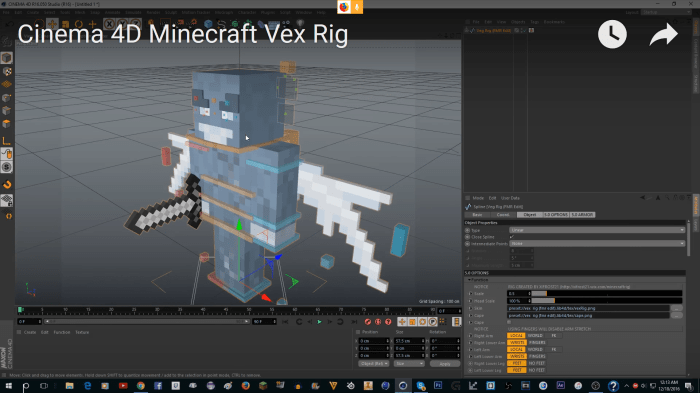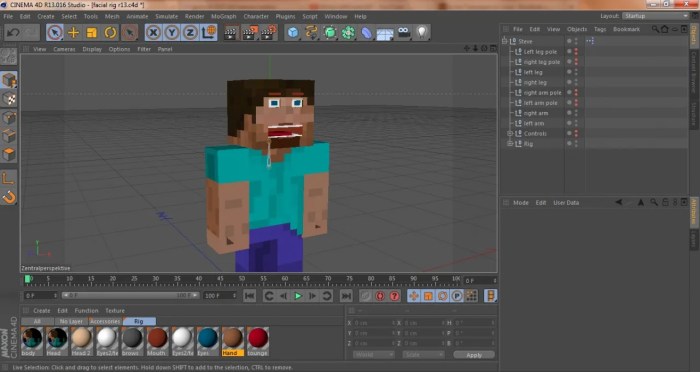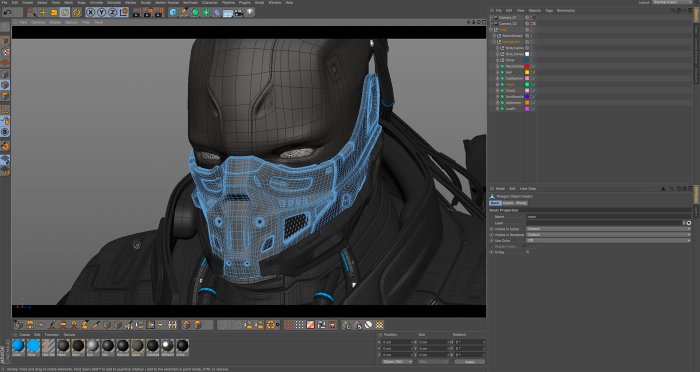Cinema 4D for Minecraft (C4D): Mastering 3D Animations takes you on a journey to elevate your Minecraft creations to a whole new level. Imagine crafting stunning 3D animations that bring your Minecraft worlds to life, from intricate block structures to dynamic character movements.
This guide will unlock the power of Cinema 4D, a professional 3D software, and equip you with the skills to seamlessly integrate your animations into the Minecraft universe.
From the basics of modeling Minecraft blocks and characters to advanced animation techniques like rigging and motion capture, this guide will cover everything you need to know. You’ll learn how to create realistic textures and materials, manipulate lighting and shadows, and optimize your workflow for efficient animation production.
Get ready to unleash your creativity and transform your Minecraft world with captivating 3D animations.
Introduction to Cinema 4D for Minecraft Animations
Cinema 4D, a powerful 3D modeling and animation software, offers a compelling avenue for crafting stunning Minecraft animations. It provides a user-friendly interface, robust tools, and seamless integration with Minecraft, enabling creators to bring their imaginative visions to life.
Benefits of Using Cinema 4D for Minecraft Animations
Utilizing Cinema 4D for Minecraft animations offers a plethora of advantages, empowering creators to elevate their work to new heights.
- Enhanced Visual Quality:Cinema 4D’s advanced rendering capabilities enable the creation of highly realistic and detailed Minecraft animations, exceeding the limitations of in-game rendering.
- Professional Workflow:Cinema 4D’s intuitive interface and comprehensive toolset streamline the animation process, facilitating efficient and professional workflow.
- Creative Flexibility:The software provides a wide range of tools and features, empowering creators to experiment with different animation styles and techniques, fostering unique and captivating visuals.
- Seamless Integration:Cinema 4D integrates seamlessly with Minecraft, enabling the effortless transfer of animations and assets between the two platforms.
Basic Functionalities of Cinema 4D for Minecraft Animation
Cinema 4D offers a suite of essential functionalities that are particularly relevant to Minecraft animation.
- Modeling:Cinema 4D’s modeling tools enable the creation of intricate Minecraft blocks, items, and characters with precision and detail. This includes tools for polygonal modeling, sculpting, and parametric modeling, allowing for versatile asset creation.
- Texturing:The software provides comprehensive texturing tools for applying realistic and stylized materials to Minecraft assets. Users can utilize various texture maps, procedural shaders, and material libraries to achieve desired visual effects.
- Animation:Cinema 4D’s animation system empowers creators to bring Minecraft assets to life through keyframing, motion paths, and physics simulation. The software’s intuitive animation tools allow for fluid and dynamic movement, enhancing the realism and engagement of animations.
- Rendering:Cinema 4D’s advanced rendering engine produces high-quality images and animations, capturing the intricacies of Minecraft scenes with stunning realism. The software offers various rendering options, including ray tracing and global illumination, enabling creators to achieve exceptional visual fidelity.
Overview of the Integration Process
Integrating Cinema 4D with Minecraft involves a straightforward process, allowing creators to seamlessly transfer animations and assets between the two platforms.
- Exporting Assets:Cinema 4D allows users to export 3D models and animations in various formats compatible with Minecraft, including OBJ, FBX, and 3DS. This enables the transfer of assets from Cinema 4D to Minecraft for use in animations and other projects.
- Importing Assets:Minecraft supports importing 3D models and animations from external sources. Creators can import assets from Cinema 4D into Minecraft, utilizing specialized plugins or tools to ensure compatibility and proper integration.
- Animation Playback:Minecraft offers a dedicated animation system that allows creators to play back animations created in external software, such as Cinema 4D. This enables the seamless integration of animations into the Minecraft game environment.
Modeling and Texturing Minecraft Assets: Cinema 4D For Minecraft (C4D): Mastering 3D Animations
Cinema 4D provides a powerful platform for crafting detailed and realistic Minecraft assets, enhancing the visual quality and immersion of animations.
Modeling Techniques for Minecraft Assets
Cinema 4D’s modeling tools offer a diverse range of techniques for creating Minecraft blocks, items, and characters.
- Polygonal Modeling:This technique involves creating and manipulating polygons to form the desired shape of an asset. It’s a versatile approach suitable for both simple and complex Minecraft assets.
- Sculpting:Cinema 4D’s sculpting tools allow for organic and detailed modeling, ideal for creating characters and complex objects with intricate features. Users can sculpt using brushes, tools, and modifiers to achieve desired shapes and details.
- Parametric Modeling:This technique involves using mathematical equations to define and manipulate 3D objects, enabling precise control and easy modification of assets. Parametric modeling is particularly useful for creating repetitive or symmetrical elements found in Minecraft, such as blocks and structures.
Best Practices for Creating Realistic Textures

Creating realistic textures for Minecraft assets in Cinema 4D involves a combination of techniques and best practices.
- Texture Resolution:High-resolution textures (e.g., 2048×2048 pixels or higher) provide greater detail and realism, particularly for close-up shots. However, it’s essential to balance resolution with performance considerations.
- Texture Maps:Different types of texture maps, such as diffuse, normal, specular, and roughness maps, can be used to create realistic materials. Utilizing multiple maps allows for finer control over surface details and appearance.
- Procedural Shaders:Cinema 4D’s procedural shaders enable the creation of complex and dynamic textures without relying on pre-made images. This allows for greater control and flexibility in achieving desired material effects.
- Material Libraries:Cinema 4D offers a range of pre-made material libraries that provide a starting point for creating realistic Minecraft assets. These libraries include materials for various surfaces, such as wood, stone, metal, and glass, simplifying the texturing process.
Examples of Unique and Stylized Assets, Cinema 4D for Minecraft (C4D): Mastering 3D Animations
Cinema 4D’s tools empower creators to create unique and stylized Minecraft assets that stand out from the ordinary.
- Custom Characters:By utilizing sculpting and texturing tools, creators can craft unique and detailed Minecraft characters with distinctive features and attire. This allows for the creation of original characters for animations and storylines.
- Stylized Environments:Cinema 4D enables the creation of stylized environments that deviate from the traditional Minecraft aesthetic. This includes crafting environments with unique lighting, textures, and materials, adding a distinct visual flair to animations.
- Custom Items:By leveraging modeling and texturing tools, creators can design unique and visually appealing items for Minecraft animations, enhancing the visual appeal and storytelling capabilities of the animations.
Animation Techniques for Minecraft Scenes
Cinema 4D provides a comprehensive set of animation tools for bringing Minecraft characters and objects to life, creating dynamic and engaging scenes.
Animating Minecraft Characters and Objects
The process of animating Minecraft characters and objects in Cinema 4D involves a combination of techniques and workflows.
- Keyframing:This technique involves setting keyframes at specific points in time, defining the position, rotation, and scale of an object. By interpolating between keyframes, Cinema 4D generates smooth and realistic animation.
- Motion Paths:Cinema 4D allows for the creation of motion paths, defining the trajectory of an object’s movement. This technique is particularly useful for animating complex movements, such as character walks or object throws.
- Physics Simulation:Cinema 4D’s physics simulation tools enable the creation of realistic movements based on physical laws. This includes simulating gravity, collisions, and other physical forces, adding a layer of realism and dynamism to animations.
Different Animation Techniques
Cinema 4D offers a range of animation techniques that can be utilized to create diverse and captivating Minecraft animations.
- Walk Cycles:Creating realistic walk cycles for Minecraft characters involves defining keyframes for the character’s legs, arms, and head, ensuring smooth and natural movement.
- Object Interactions:Animating interactions between objects, such as a character picking up an item or opening a door, requires careful coordination of movements and timing to create believable interactions.
- Camera Movements:Utilizing camera movements, such as pans, zooms, and tilts, adds dynamism and visual interest to Minecraft animations. Careful camera work can enhance the storytelling and engagement of animations.
Seamless Integration with Minecraft

Achieving seamless integration of Cinema 4D animations into Minecraft involves careful consideration of several factors.
- Animation Formats:Exporting animations in compatible formats, such as OBJ or FBX, ensures proper integration with Minecraft’s animation system.
- Scaling and Positioning:Ensuring that animations are scaled and positioned correctly within the Minecraft game environment is crucial for achieving seamless integration.
- Animation Triggers:Minecraft offers various animation triggers, such as player actions or events, that can be used to initiate animations imported from Cinema 4D. Understanding and utilizing these triggers is essential for creating interactive and engaging animations.
Lighting and Rendering for Minecraft Animations
Cinema 4D’s lighting and rendering capabilities enable the creation of stunning and realistic Minecraft animations, enhancing the visual impact and immersion of scenes.
Creating Realistic Lighting and Shadows
Achieving realistic lighting and shadows in Cinema 4D is crucial for creating visually compelling Minecraft animations.
- Light Sources:Cinema 4D offers various light sources, including point lights, spotlights, and area lights, allowing for the creation of diverse lighting setups. Experimenting with different light types and placements can enhance the mood and atmosphere of animations.
- Shadow Settings:Adjusting shadow settings, such as shadow resolution, distance, and intensity, can create realistic and visually appealing shadows that enhance the depth and dimension of Minecraft scenes.
- Ambient Occlusion:This technique simulates the subtle darkening of surfaces due to ambient light bouncing around objects. Applying ambient occlusion can enhance the realism and depth of Minecraft animations, particularly in enclosed spaces.
Rendering Techniques and Impact
Cinema 4D offers various rendering techniques that impact the final animation output.
- Ray Tracing:This technique simulates the path of light rays, creating highly realistic reflections, refractions, and shadows. Ray tracing can significantly enhance the visual quality of Minecraft animations, particularly for scenes with complex lighting and reflections.
- Global Illumination:This technique simulates the way light bounces around a scene, creating a more realistic and immersive lighting environment. Global illumination can enhance the overall mood and atmosphere of animations, particularly for scenes with multiple light sources.
- Render Passes:Rendering in multiple passes, such as separate passes for shadows, reflections, and ambient occlusion, allows for greater control over the final image. This technique is particularly useful for achieving specific visual effects or for post-processing in other software.
Tips for Optimizing Rendering Settings
Optimizing rendering settings in Cinema 4D is essential for achieving high-quality results while maintaining efficient workflow.
- Resolution:Balancing resolution with rendering time is crucial. Higher resolutions produce sharper images but require more processing power. Experiment with different resolutions to find the optimal balance between quality and efficiency.
- Sample Rate:Increasing the sample rate enhances the quality of shadows, reflections, and other effects, but also increases rendering time. Experiment with different sample rates to find the best balance between quality and performance.
- Render Engine:Cinema 4D offers different render engines, each with its strengths and weaknesses. Choosing the right render engine based on project requirements can optimize rendering time and quality.
Advanced Techniques and Workflows
Cinema 4D offers a range of advanced techniques and workflow optimizations that can enhance the complexity and efficiency of Minecraft animations.
Advanced Techniques
Exploring advanced techniques in Cinema 4D opens up new possibilities for creating complex and visually stunning Minecraft animations.
- Rigging:Rigging involves creating a skeletal structure for characters, enabling animators to manipulate the character’s pose and movement with greater control. Rigging is essential for creating realistic and dynamic character animations.
- Character Animation:Animating characters in Cinema 4D requires understanding the principles of motion and timing. Utilizing techniques such as keyframing, motion paths, and physics simulation, animators can create expressive and engaging character animations.
- Motion Capture:This technique involves capturing human movement using sensors and translating it into animation data. Motion capture can be used to create realistic and natural-looking character animations, particularly for complex movements and actions.
Workflow Optimization
Optimizing workflow in Cinema 4D is essential for efficient and productive animation production.
- Project Organization:Maintaining a well-organized project structure, including folders for assets, scenes, and animations, simplifies workflow and reduces errors.
- Hotkeys and Shortcuts:Learning and utilizing hotkeys and shortcuts in Cinema 4D can significantly speed up the animation process, saving time and improving efficiency.
- Plugins and Scripts:Cinema 4D offers a range of plugins and scripts that can automate tasks and enhance workflow. Exploring and utilizing relevant plugins can streamline the animation process and increase productivity.
Examples of Complex Animations
Cinema 4D has been used to create complex and visually stunning Minecraft animations, showcasing the software’s capabilities.
- Animated Storylines:Creators have used Cinema 4D to craft elaborate animated storylines, featuring intricate character animations, detailed environments, and dynamic camera work. These animations showcase the power of Cinema 4D for storytelling and visual expression.
- Music Videos and Trailers:Cinema 4D has been utilized to create captivating music videos and trailers for Minecraft games and mods, featuring stylized visuals, dynamic animation, and engaging storytelling.
- Interactive Experiences:Cinema 4D has been used to create interactive Minecraft experiences, utilizing animation and visual effects to create engaging and immersive gameplay elements.
Best Practices and Troubleshooting

Following best practices and understanding common troubleshooting techniques can enhance the quality and efficiency of Minecraft animations created with Cinema 4D.
Best Practices for Working with Cinema 4D and Minecraft
Adhering to best practices ensures smooth workflow and high-quality results when working with Cinema 4D and Minecraft.
- Optimize Asset Sizes:Keeping asset sizes manageable reduces rendering time and improves performance. Utilize low-poly modeling techniques and compress textures to optimize asset sizes.
- Use Proper Naming Conventions:Implementing consistent naming conventions for assets, scenes, and animations improves organization and reduces errors.
- Back Up Regularly:Regularly backing up project files ensures that progress is not lost due to technical issues or accidents.
Solutions for Common Issues
Understanding common issues encountered during the animation process in Cinema 4D and Minecraft can help creators overcome challenges and achieve desired results.
- Asset Import Errors:Ensure that assets are exported and imported in compatible formats and that proper scaling and positioning are maintained.
- Animation Playback Issues:Verify that animations are exported with correct timing and that triggers are set up correctly within Minecraft.
- Rendering Errors:Check for errors in scene setup, rendering settings, and asset compatibility to resolve rendering issues.
Tips for Optimizing Performance
Optimizing performance in Cinema 4D is crucial for maintaining a smooth workflow and achieving efficient rendering.
- Hardware Considerations:Ensure that the computer system meets the minimum requirements for Cinema 4D and has sufficient RAM and processing power to handle complex scenes and animations.
- Scene Optimization:Simplify scenes by reducing the number of objects, polygons, and textures to improve rendering performance.
- Render Settings:Adjust rendering settings, such as resolution, sample rate, and render engine, to optimize performance without sacrificing quality.
Concluding Remarks
Mastering Cinema 4D for Minecraft animations is not just about learning software; it’s about unlocking a new dimension of creative expression. By combining the power of Cinema 4D with the endless possibilities of Minecraft, you can create truly immersive and engaging experiences.
So, dive into the world of 3D animation, experiment with different techniques, and let your imagination run wild. The Minecraft world awaits your animated creations!
Frequently Asked Questions
Is Cinema 4D compatible with all versions of Minecraft?
Cinema 4D can be used to create animations for any version of Minecraft, but the integration process may vary slightly depending on the specific version.
What are some popular plugins or tools for integrating Cinema 4D animations into Minecraft?
There are several plugins and tools available that facilitate the integration of Cinema 4D animations into Minecraft. Some popular options include the “Minecraft: Story Mode” plugin and the “Cinema 4D to Minecraft Exporter” tool.
Are there any specific hardware requirements for using Cinema 4D for Minecraft animations?
Cinema 4D is a resource-intensive software, so it’s recommended to have a computer with a powerful processor, ample RAM, and a dedicated graphics card for optimal performance.